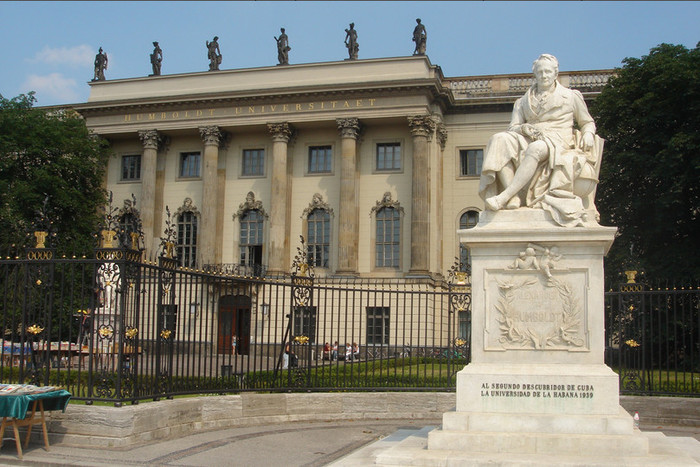Alexander von Humboldt
(Alexander von Humboldt, 1769-1859) - famous
German encyclopedist, geographer and
traveler,
naturalist. Named after Alexander
lake and river
in state
Nevada (USA), a crater on the moon, mountains in Australia,
new zealand,
Central Asia, glacier in Greenland, Peruvian
flow -
cold current washing the shores of the South
America, he discovered
it's a current in 1802, a city and a bay in California.
Alexander Humboldt is one of the greatest
scientists.
He was a rare scientist in the 19th century
encyclopedist.
Contemporaries called him "the king of sciences and
friend of kings,
"Aristotle of the 19th century".
Baron Alexander Friedrich Wilhelm was born
von Humboldt
September 14, 1769 in Berlin. He is second
son not too
noble and poor nobleman from Pomerania.
Humboldt lived to be 90 years old. Almost every
he was busy
productive and hard work.
The father of the future traveler served in
major
adjutant to Duke Ferdinand
Brunswick,
later became court chamberlain of the Saxon
elector,
spent the rest of his life in Berlin at court
Friedrich II,
king of Prussia. Humboldt's mother, nee
Colomb,
had a considerable fortune. She had
house in Berlin
Tegel Castle and other property.
The Humboldts gave the children glitter to
time education.
At first they were homeschooled. their tutor
was a big fan
Rousseau Christian Kunt. He instilled in them
love for history
philosophy and literature.
Botany with children was engaged in
subsequently
famous physician Dr. Ludwig Geim.
He introduced them
with the latest discoveries in the field
natural sciences.
As teachers in Berlin for children
invited
well-known scientists who taught
boys
ancient languages, legal sciences,
philosophy. 
At the urging of their mother, the Humboldt brothers
1787 set off
to continue education in
Frankfurt University.
But a year later, Alexander returned
to Berlin and took up
botany and Greek, then entered
in 1789 with his brother Karl in Göttingen
university and began to study all sciences at once.
In 1790, Alexander, together with Georg Forster -
one of the founders of scientific
geographical travel,
J. Cook's companion, traveled
in Europe.
Forster taught a young friend during
travel, nature observation techniques,
and the student learned
lessons and developed them, eventually reaching
significant results.
Returning from a trip, Humboldt
continues education
in Hamburg at the Trade Academy, then
in Freiburg in
Mining Academy, where he became his teacher
another outstanding
geologist A. G. Werner.
Science passionately attracted Humboldt,
and its different areas.
But from 1792 to 1797, i.e., for five whole years,
he had to
work in Franconia as a mining official.
Young official
engaged in mineralogy during the trips
and even published in various scientific journals
a number of articles.
After the death of his mother, Humboldt received
85 thousand thalers as an inheritance and smog
dedicate yourself entirely to what you love -
travel and science. On your own
means he
organized an expedition and invited to participate
in it is E. Bonpland, a talented botanist,
not having money, but also delirious
travel. On June 5, 1799, they set off
to America on the Pizarro corvette.
The scientist wrote: “My main goal is the physics of the world,
structure
globe, air analysis, physiology
plants and animals, finally - general relations
organic beings in
inanimate nature ... "Humboldt performed
this daunting task, he became the founder
new complex method of cognition and study of the world.
Only to achieve this goal it took more than one
journey, but a lifetime.
In the first expedition, which became for Humboldt
"finest hour", the young scientist visited
Venezuela, discovered until that time only
for the Spaniards, spent four months on the river
Orinoco, proving her connection to the Amazon.
He collected a huge amount of material in Venezuela,
then went to Cuba, after which he returned
to the mainland. Here he went up the river Magdalena and,
overcoming the mountain pass, went to the capital
Ecuadorian city of Quito, located on a slope
Pichincha volcano at an altitude of 2818 m above sea level.
Then he visited the Andes and explored the upper reaches
Amazons. Much attention was paid to Humboldt
devoted to the study of volcanoes. He climbed to a height of 5881 m
on Chimborazo and, although he did not reach the summit
(the height of the volcano is 6272 m), but still installed
record. Before to such a high mark
not a single researcher did.
In March 1803 the travelers arrived
to Mexico, here in a year they bypassed all the provinces.
Humboldt continued to study volcanoes,
including the most famous Popocatepetl.
Travelers departed from Veracruz
to Havana, and from it to the cities of North America
Washington and Philadelphia. Before traveling to
US German scientist signed off tentatively
with President Jefferson, who also
was a great scientist. In Washington Humboldt
met with him and with other government officials
husbands. He received an invitation to stay in the USA,
but refused and, together with Bonpland in August
1804 returned to Europe.
Although the Humboldt expedition did not commit any
territorial discoveries, historians consider it
one of the greatest in terms of scientific results.
Scientists have collected huge collections: in one
only the herbarium had 6 thousand specimens of plants,
of which almost half was not known to science.
Upon his return from America to Europe, Humboldt
For more than twenty years he has worked with
other eminent scientists their large collections
in Paris. In 1807 - 1834 the Journey
to the equinoctial regions of the New World in 1799-1804."
in 30 volumes, most of it (16 volumes) were
descriptions of plants, 5 volumes - cartographic and
astronomical and geodetic materials, the rest
– travel description, zoology and comparative
anatomy and more. Humboldt published on
materials of the expedition and a number of other works,
for example, "Pictures of nature."
1827 - Humboldt moves from Paris to Berlin,
here he acts as an adviser and
chamberlain of the Prussian king. 
1829 - the great traveler, naturalist and
geographer makes a trip to Russia -
to the Caspian Sea, to the Altai and the Urals.
He described the nature of Asia in the works “Fragments on
Geology and Climatology of Asia" (1831) and
"Central Asia" (1915).
In the monumental work Cosmos, Humboldt
later tried to generalize all
scientific knowledge about the Earth and the Universe.
This work by Humboldt is outstanding
product of advanced materialistic
natural philosophy of the 19th century. Proceedings of Humboldt
made a great contribution to the development of natural science.
Alexander Humboldt created physical geography,
which was designed to reveal patterns
earth's surface, using a comparative
method and on the basis of general principles. views
Humboldt became the basis of landscape science
and general physical geography, as well as climatology
and plant geography. Humboldt were
regularities of zonal
the distribution of vegetation on the earth's surface,
in the geography of plants, an ecological
direction. He made a great contribution to the study
climate and the first widely applied to
average climate characteristics
indicators, he developed the method of isotherms
and a schematic map of their distribution was drawn up
across the Northern Hemisphere. Humboldt gave a detailed
characteristics of coastal and continental climates,
the processes of their formation and the reasons for the differences are indicated.
The scientist-naturalist was absolutely disinterested,
when it comes to science. For your famous
expedition Humboldt spent 52 thousand thalers,
costs for processing and publishing results
amounted to 180 thousand, i.e., their entire personal fortune
Humboldt used up for scientific purposes.
Humboldt had no family and was not married.
Science was his only love. science were
given life and fortune. material in old age
the position of the scientist was very unenviable.
Since he owed the banker Mendelssohn
a significant amount, I did not even know
whether the things in the house belong to him.
In April 1859, Humboldt caught a bad cold.
and died a few days later. He didn't live up to
ninetieth anniversary in just four months and
was buried with great honors at the expense of the state.
